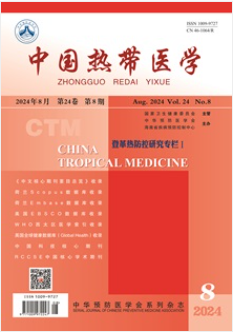山西省2015-2019年输入性疟疾病例诊断分析
引用次数: 0
摘要
目的分析山西省2015-2019年输入性疟疾病例诊断情况,为疟疾消除后预防再传播监测提供依据。方法通过国家传染病信息报告管理系统(IDIRMS)和寄生虫病信息报告管理系统(PDIRMS)收集山西省2015 - 2019年输入性疟疾病例数据并进行整理。采用卡方检验和秩和检验对输入性疟疾病例的诊断机构和诊断时效性进行描述和分析。结果2015-2019年山西省共报告输入性疟疾病例72例,全部为境外输入病例,其中恶性疟占68.1%(49/72),间日疟占18.1%(13/72),卵形疟占8.3%(6/72),疟2.8%(2/72),混合感染2.8%(2/72)。所有这些都是通过实验室检查诊断的(100.0%)。医疗机构诊断率为95.8%(69/72),其中省级医疗机构诊断率为73.9%(51/69),市级医疗机构诊断率为21.7%(15/69),县级医疗机构诊断率为4.3%(3/69)。疟疾病例从发病到诊断的中位时间为5天,其中从发病到首次就诊的中位时间为3天。发病至首次就诊时间、首次就诊至确诊时间差异均有统计学意义(P <0.05),疟疾病例四分位数间隔由2017年最长的10天缩短至2019年最短的0天。结论山西省医疗机构在疟疾病例检测和监测工作中发挥着重要作用。提高县级医疗机构的诊断意识和诊断能力,发挥哨点医院在消除疟疾后预防再传播监测中的作用。摘要:目的 分析山西省2015—2019年输人性疟疾病例诊断情况,为消除疟疾后防止输人再传播的监测工作提 供依据。 方法通过传染病报告信息管理系统和寄生虫病防治信息管理系统,收集整理2015 - 2019年山西省疟疾病例信息,对其诊断机构,诊断及时性等情况采用χ2检验,秩和检验进行统计分析。结果2015 - 2019年全省共报告疟疾病例72例,均为境外输人性病例,其中恶性疟占68.1%(49/72),间日疟占18.1%(13/72),卵形疟占8.3%(6/72),三日疟占2.8%(2/72),混合感染2.8%(2/72)。所有病例均为实验室确诊病例,镜检检测率均为100.0% .95.8%(69/72)的病例在医疗机构诊断,而69例在医疗机构诊断的病例中,73.9%(51/69)在省级医疗机构诊断,21.7%(15/69)在市级医疗机构诊断,仅4.3%(3/69)在县级医疗机构诊断。疟疾病例从发病——确诊时间中位数为5 d,其中发病——初诊时间中位数为3 d,发病——初诊和初诊-确诊时间各年份差异均有统计学意义,四分位数间距由2017年最长10 d的缩短为2019年最短的0 d。结论 山西省医疗机构在疟疾病例发现和监测中具有重要作用。疟疾病例诊断以省级医疗机构为主,提 示市、县级医疗机构的诊断水平较低。今后要加强市县级医疗机构的培训以提高其疟疾诊断意识和诊断能力。本文章由计算机程序翻译,如有差异,请以英文原文为准。
Analysis on the diagnosis of imported malaria cases in Shanxi, 2015-2019
Objective To provide the basis for the surveillance to prevent re-transmission after malaria elimination by analyzing the diagnosis imported malaria cases in Shanxi Province during 2015-2019. Methods Data on imported malaria cases in Shanxi Province from 2015 to 2019 were collected and sorted through the National Infectious Diseases Information Reporting Management System (IDIRMS) and the Parasitic Diseases Information Reporting Management System (PDIRMS). Diagnostic institutions and diagnostic timeliness of imported malaria cases were described and analyzed by chi-square test and rank-sum test. Results A total of 72 imported malaria cases were reported in Shanxi during 2015-2019, all cases were imported from abroad, among which falciparum malaria accounted for 68.1% (49/72), vivax malaria 18.1% (13/72), ovale malaria 8.3% (6/72), malariae malaria 2.8% (2/72), and mixed infection 2.8% (2/72). And all of which were diagnosed with laboratory tests (100.0%). The rate of diagnosis in medical institutions was 95.8% (69/72), while 73.9% (51/69) were diagnosed in provincial medical institutions, 21.7% (15/69) were diagnosed in municipal medical institutions, 4.3% (3/69) of 69 cases diagnosed in medical institutions were diagnosed in county-level medical institutions. The median time from onset to diagnosis of malaria cases was 5 days, in which the median time from onset to first visit was 3 day. There were significant difference in the time both from onset to first visit and first visit to diagnosis ( P <0.05), the interquartile interval of malaria cases was shortened from the longest 10 days in 2017 to the shortest zero days in 2019. Conclusion Medical institutions in Shanxi Province play an important role in malaria case detection and monitoring. We should improve the diagnostic awareness and capabilities of county-level medical institutions, and to play the role of sentinel hospitals in the surveillance of preventing re-transmission after malaria elimination. 摘要:目的 分析山西省2015—2019年输人性疟疾病例诊断情况,为消除疟疾后防止输人再传播的监测工作提 供依据。 方法 通过传染病报告信息管理系统和寄生虫病防治信息管理系统,收集整理2015—2019年山西省疟疾病 例信息,对其诊断机构、诊断及时性等情况采用 χ 2 检验、秩和检验进行统计分析。 结果 2015—2019年全省共报告疟 疾病例72例,均为境外输人性病例,其中恶性疟占68.1%(49/72),间日疟占18.1%(13/72),卵形疟占8.3%(6/72),三日 疟占2.8%(2/72),混合感染2.8%(2/72)。所有病例均为实验室确诊病例,镜检检测率均为100.0%。95.8%(69/72)的病 例在医疗机构诊断,而69例在医疗机构诊断的病例中,73.9%(51/69)在省级医疗机构诊断,21.7%(15/69)在市级医疗 机构诊断,仅4.3%(3/69)在县级医疗机构诊断。疟疾病例从发病-确诊时间中位数为5 d,其中发病-初诊时间中位数 为3 d,发病-初诊和初诊-确诊时间各年份差异均有统计学意义,四分位数间距由2017年最长的10 d缩短为2019年最 短的0 d。 结论 山西省医疗机构在疟疾病例发现和监测中具有重要作用。疟疾病例诊断以省级医疗机构为主,提 示市、县级医疗机构的诊断水平较低。今后要加强市县级医疗机构的培训以提高其疟疾诊断意识和诊断能力。
求助全文
通过发布文献求助,成功后即可免费获取论文全文。
去求助
来源期刊
CiteScore
0.60
自引率
0.00%
发文量
13927
期刊介绍:
China Tropical Medicine, was approved by the Ministry of Science and Technology in 2001, is the only tropical medicine periodical under the charge of the National Health Commission of China. It’s organized by Hainan Provincial Center for Disease Prevention and Control, and Chinese Preventive Medicine Association.
The journal is indexed by the following database: Scopus database, Embase database, EBSCO Database, The Western Pacific Region index medicus (WPRIM), American Chemical Abstracts (CA), International Centre for Agricultural and Biological Sciences Research Database (CABI), Global Health Database, Database of the Ulrich's Periodicals Directory, China Science and Technology Core Journals, China Core Journals (Selection) Database, Database of Chinese Biomedical Literature, Comprehensive Evaluation Database of Chinese Academic Journals, CAJCD Code of Conduct Excellent Journal, Database of Chinese SCI-Tech Periodicals, China Journal Full Text Database.

 求助内容:
求助内容: 应助结果提醒方式:
应助结果提醒方式:


